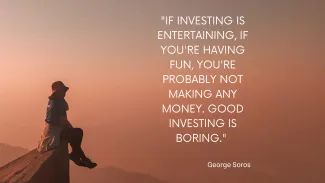
Why Good Investing Feels Boring — And How Creatives Can Embrace It
For a Creative Mind the Discipline Required in Investing Can Lead to Ennui and Self-Sabotage
If you’re a creative professional—a designer, writer, filmmaker, architect or maker of anything—you know that your work thrives on innovation, fresh ideas, and pushing boundaries. But when it comes to investing, the best approach often feels... well, boring.
Good investing is steady, disciplined, and focused on long-term growth rather than chasing the latest shiny thing. This can lead to a feeling of ennui—a kind of boredom or restlessness—that tempts you to seek out novelty, new trends, or “hot” investments. But chasing excitement in your portfolio can be risky, especially when your income is already unpredictable.
Here’s how you, as a creative entrepreneur, can deal with your natural attraction to novelty while still building lasting financial security.
Why Boring Investing Is Actually a Superpower
Your creative career might be full of surprises—one month you land a big project, the next you’re waiting for the next gig. But your investing doesn’t have to mirror that rollercoaster.
Consistency beats excitement. Quiet, steady investing strategies reduce stress and help you avoid emotional decisions that can derail your progress.
Boring means reliable. A well-constructed portfolio quietly compounds wealth over time, helping you fund your dreams and your business.
Less noise, more freedom. When your investments don’t demand constant attention, you free up mental space to focus on your craft.
Understanding the Urge for Novelty
It’s natural to crave newness. Your creative mind thrives on fresh ideas and exploration. But in investing, chasing the latest trend—whether it’s a hot AI stock, a new crypto coin, or a flashy sector—can lead to costly mistakes.
This urge often comes from boredom or impatience, especially when your portfolio is performing steadily but without fireworks. Social media and financial news amplify this by spotlighting dramatic gains and “must-have” investments.
How to Channel Your Creativity Without Jeopardizing Your Financial Future
1. Build Awareness Around Your Impulses
Recognize when you’re feeling restless or bored with your portfolio. Ask yourself: “Am I chasing this because it fits my goals, or just because it’s exciting?” This pause can prevent impulsive moves.
2. Reframe What Success Looks Like
Instead of measuring success by excitement or quick wins, celebrate the power of consistency. Think of your portfolio like a creative project that grows quietly over time—steady progress is a masterpiece in itself.
3. Stay Connected to Your Why
Regularly revisit your financial goals—whether its building a ceramic studio, funding a writing sabbatical or achieving financial security so you can choose projects based on passion, not necessity. Keeping these in mind makes the “boring” parts of investing feel purposeful.
4. Automate and Simplify
Use automatic contributions and rebalancing to keep your portfolio on track. This reduces the temptation to tinker and helps you stick to your plan.
5. Limit Risky Ideas to a Small Portion of Your Portfolio
If you feel that you absolutely must explore new ideas, set aside a small, defined part of your investments for experimentation. This satisfies your desire for novelty without risking your core financial stability.
Practical Tips for Self-Employed Creatives
Create a flexible budget that accounts for your irregular income and sets aside savings during good months for leaner times.
Build an emergency fund covering 6-12 months of expenses to provide peace of mind and reduce financial stress.
Work with an advisor who understands your unique income patterns and can help you plan for taxes, savings, and investments tailored to your lifestyle.
Limit how often you check your portfolio to avoid unnecessary anxiety or impulsive trades.
Celebrate milestones like hitting savings targets or staying the course during market ups and downs.
Final Thoughts
As a creative professional, your work is fueled by innovation and excitement. But your investing doesn’t have to be a source of stress or boredom. By understanding your natural attraction to novelty and learning to channel it wisely, you can build a financial foundation that supports your creativity and your life.
Remember: the most successful investors aren’t the ones chasing the latest fad—they’re the ones who show up, stay disciplined, and let their money grow quietly in the background. That kind of “boring” investing is what will ultimately give you the freedom to create on your own terms.
If you’re a self-employed creative looking for guidance on managing your unique financial journey, consider partnering with an advisor who understands your world and can help you build a plan that fits your life and your dreams.

